GEOLOGY
Scottish isles may solve mystery of 'Snowball Earth'Pallab Ghosh
Science Correspondent•@BBC Pallab
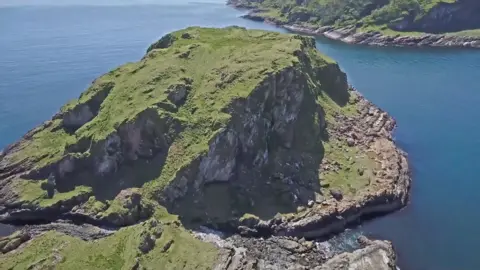
UCL
A cluster of Scottish islands could help solve one of our planet's greatest mysteries, scientists say.
The Garvellach islands off the west coast of Scotland are the best record of Earth entering its biggest ever ice age around 720 million years ago, researchers have discovered.
The big freeze, which covered nearly all the globe in two phases for 80 million years, is known as "Snowball Earth", after which the first animal life emerged.
Clues hidden in rocks about the freeze have been wiped out everywhere - except in the Garvellachs. Researchers hope the islands will tell us why Earth went into such an extreme icy state for so long and why it was necessary for complex life to emerge.
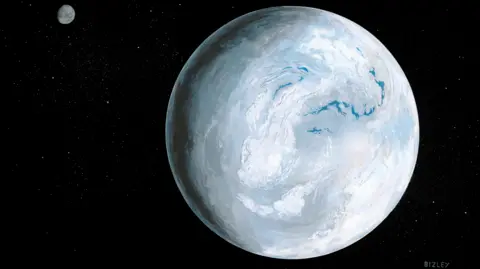
A cluster of Scottish islands could help solve one of our planet's greatest mysteries, scientists say.
The Garvellach islands off the west coast of Scotland are the best record of Earth entering its biggest ever ice age around 720 million years ago, researchers have discovered.
The big freeze, which covered nearly all the globe in two phases for 80 million years, is known as "Snowball Earth", after which the first animal life emerged.
Clues hidden in rocks about the freeze have been wiped out everywhere - except in the Garvellachs. Researchers hope the islands will tell us why Earth went into such an extreme icy state for so long and why it was necessary for complex life to emerge.

SPL
The Earth became almost completely covered in ice during the longest and most severe ice age in the planet's history
Layers of rock can be thought of as pages of a history book – with each layer containing details of the Earth’s condition in the distant past.
But the critical period leading up to Snowball Earth was thought to be missing because the rock layers were eroded by the big freeze.
Now a new study by researchers at University College, London, has revealed that the Garvellachs somehow escaped unscathed. It may be the only place on Earth to have a detailed record of how the Earth entered one of the most catastrophic periods in its history – as well as what happened when the first animal life emerged when the snowball thawed hundreds of millions of years ago.
Back then Scotland was in a completely different place because the continents have moved over time. It was south of the Earth’s equator and had a tropical climate, until it and the rest of the planet became engulfed in ice.
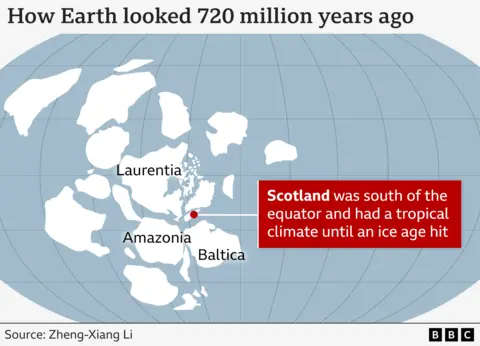
“We capture that moment of entering an ice age in Scotland that is missing in all other localities in the world,” Prof Graham Shields of University College London, who led the research, told BBC News.
“Millions of critical years are missing in other places because of glacial erosion – but it is all there in the layers of rock in the Garvellachs.”
The islands in the Inner Hebrides of Scotland are uninhabited, apart from a team of scientists working out of the main island's solitary building, although there are also the ruins of a 6th Century Celtic monastery.
The breakthrough was made by Prof Shield’s PhD student, Elias Rugen, whose results have been published in the Journal of the Geological Society of London. Elias is the first to date the rock layers and identify them as from the critical period that is missing from all other rock formations in all other parts of the world.
His discovery puts the Garvellachs in line for one of the biggest accolades in science: the golden spike hammered in at locations identified as the best record of planet-changing geological moments – though to ward off thieves the spike is not actually made of gold.
The Earth became almost completely covered in ice during the longest and most severe ice age in the planet's history
Layers of rock can be thought of as pages of a history book – with each layer containing details of the Earth’s condition in the distant past.
But the critical period leading up to Snowball Earth was thought to be missing because the rock layers were eroded by the big freeze.
Now a new study by researchers at University College, London, has revealed that the Garvellachs somehow escaped unscathed. It may be the only place on Earth to have a detailed record of how the Earth entered one of the most catastrophic periods in its history – as well as what happened when the first animal life emerged when the snowball thawed hundreds of millions of years ago.
Back then Scotland was in a completely different place because the continents have moved over time. It was south of the Earth’s equator and had a tropical climate, until it and the rest of the planet became engulfed in ice.

“We capture that moment of entering an ice age in Scotland that is missing in all other localities in the world,” Prof Graham Shields of University College London, who led the research, told BBC News.
“Millions of critical years are missing in other places because of glacial erosion – but it is all there in the layers of rock in the Garvellachs.”
The islands in the Inner Hebrides of Scotland are uninhabited, apart from a team of scientists working out of the main island's solitary building, although there are also the ruins of a 6th Century Celtic monastery.
The breakthrough was made by Prof Shield’s PhD student, Elias Rugen, whose results have been published in the Journal of the Geological Society of London. Elias is the first to date the rock layers and identify them as from the critical period that is missing from all other rock formations in all other parts of the world.
His discovery puts the Garvellachs in line for one of the biggest accolades in science: the golden spike hammered in at locations identified as the best record of planet-changing geological moments – though to ward off thieves the spike is not actually made of gold.
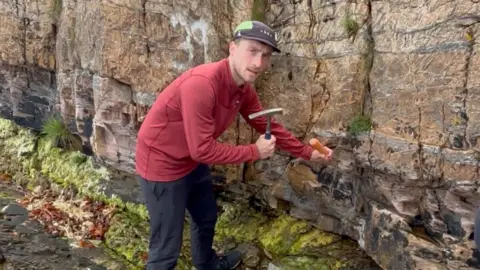
UCL
The discovery was made by Elias Rugen, here pretending to hammer in a coveted golden spike. For now he's making do with a carrot
Elias has taken many of the judges of the golden spike, formally known as members of the “Cryogenian sub-commission”, several times to the rock faces to press his case.
The next stage is to allow the wider geological community to voice any objections or to come up with a better candidate. If there are none, then the spike could be hammered in next year.
The prize would raise the scientific profile of the location and attract further research funding.
The discovery was made by Elias Rugen, here pretending to hammer in a coveted golden spike. For now he's making do with a carrot
Elias has taken many of the judges of the golden spike, formally known as members of the “Cryogenian sub-commission”, several times to the rock faces to press his case.
The next stage is to allow the wider geological community to voice any objections or to come up with a better candidate. If there are none, then the spike could be hammered in next year.
The prize would raise the scientific profile of the location and attract further research funding.
Scottish and Irish rocks may be rare record of ‘snowball Earth’, study suggests
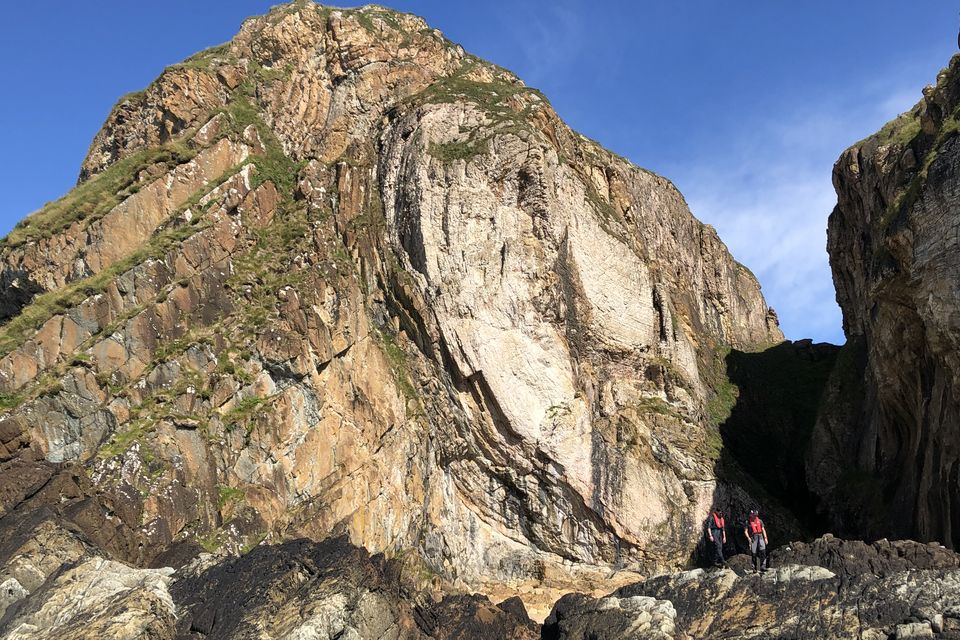
The Port Askaig Formation is made up of layers of rock up to 1.1km thick

The Port Askaig Formation is made up of layers of rock up to 1.1km thick
(Graham Shields/UCL)
By Nina Massey, PA Science Correspondent
By Nina Massey, PA Science Correspondent
Yesterday
A rock formation that spans Ireland and Scotland may be a rare record of snowball Earth – a crucial moment in planetary history when the globe was covered in ice.
The Port Askaig Formation, which is made up of layers of rock up to 1.1km thick, was likely to have been laid down between 662 and 720 million years ago during the Sturtian glaciation, research suggests.
This was the first of two global freezes thought to have triggered the development of complex life.
These rocks record a time when Earth was covered in iceProfessor Graham Shields, senior author
According to the new study, one section of exposed rock, found on Scottish islands called the Garvellachs, is unique as it shows the transition into snowball Earth from a previously warm, tropical environment.
Other rocks that formed at a similar time, like some in North America and Namibia, are missing this transition.
Therefore researchers believe their findings may be the world’s most complete record of snowball Earth – a theory that suggests Earth’s oceans and land surfaces were covered by ice from the poles to the Equator during at least two extreme cooling events between 2.4 billion and 580 million years ago.
Senior author Professor Graham Shields, of University College London (UCL) Earth Sciences, said: “These rocks record a time when Earth was covered in ice.
“All complex, multicellular life, such as animals, arose out of this deep freeze, with the first evidence in the fossil record appearing shortly after the planet thawed.”
First author Elias Rugen, a PhD candidate at UCL Earth Sciences, said: “Our study provides the first conclusive age constraints for these Scottish and Irish rocks, confirming their global significance.”
But in Scotland by some miracle the transition can be seenElias Rugen, first author
He explained that most areas of the world are missing the layers in the rocks that record a tropical environment and mark the transition, because the ancient glaciers scraped and eroded away the rocks underneath.
“But in Scotland by some miracle the transition can be seen,” Mr Rugen said.
Lasting some 60 million years, the Sturtian glaciation was one of two big freezes that occurred during the Cryogenian Period – between 635 and 720 million years ago.
For billions of years before this, life consisted only of single-celled organisms and algae.
After this period, complex life quickly emerged, with most animals today similar in fundamental ways to the types of life forms that evolved more than 500 million years ago.
One theory is that the hostile nature of the extreme cold may have prompted single-celled organisms to co-operate with each other, forming multicellular life.
As soon as the world warmed up, all of life would have had to compete in an arms race to adapt. Whatever survived were the ancestors of all animalsProfessor Graham Shields, senior author
The advance and retreat of the ice across the planet was thought to have happened relatively quickly, over thousands of years, because of the albedo effect – that is, the more ice there is, the more sunlight is reflected back into space, and vice versa.
Prof Shields explained: “The retreat of the ice would have been catastrophic. Life had been used to tens of millions of years of deep freeze.
“As soon as the world warmed up, all of life would have had to compete in an arms race to adapt. Whatever survived were the ancestors of all animals.”
For the new study, the research team analysed samples of sandstone from Port Askaig Formation as well as from the older, 70-metre thick Garbh Eileach Formation underneath.
The researchers said the new age constraints for the rocks may provide the evidence needed for the site to be declared as a marker for the start of the Cryogenian Period.
This marker, known as a Global Boundary Stratotype Section and Point (GSSP), is sometimes referred to as a golden spike, as a gold spike is driven into the rock to mark the boundary, and these sites attract visitors from around the world.
The study, led by UCL researchers, is published in the Journal of the Geological Society of London.
A rock formation that spans Ireland and Scotland may be a rare record of snowball Earth – a crucial moment in planetary history when the globe was covered in ice.
The Port Askaig Formation, which is made up of layers of rock up to 1.1km thick, was likely to have been laid down between 662 and 720 million years ago during the Sturtian glaciation, research suggests.
This was the first of two global freezes thought to have triggered the development of complex life.
These rocks record a time when Earth was covered in iceProfessor Graham Shields, senior author
According to the new study, one section of exposed rock, found on Scottish islands called the Garvellachs, is unique as it shows the transition into snowball Earth from a previously warm, tropical environment.
Other rocks that formed at a similar time, like some in North America and Namibia, are missing this transition.
Therefore researchers believe their findings may be the world’s most complete record of snowball Earth – a theory that suggests Earth’s oceans and land surfaces were covered by ice from the poles to the Equator during at least two extreme cooling events between 2.4 billion and 580 million years ago.
Senior author Professor Graham Shields, of University College London (UCL) Earth Sciences, said: “These rocks record a time when Earth was covered in ice.
“All complex, multicellular life, such as animals, arose out of this deep freeze, with the first evidence in the fossil record appearing shortly after the planet thawed.”
First author Elias Rugen, a PhD candidate at UCL Earth Sciences, said: “Our study provides the first conclusive age constraints for these Scottish and Irish rocks, confirming their global significance.”
But in Scotland by some miracle the transition can be seenElias Rugen, first author
He explained that most areas of the world are missing the layers in the rocks that record a tropical environment and mark the transition, because the ancient glaciers scraped and eroded away the rocks underneath.
“But in Scotland by some miracle the transition can be seen,” Mr Rugen said.
Lasting some 60 million years, the Sturtian glaciation was one of two big freezes that occurred during the Cryogenian Period – between 635 and 720 million years ago.
For billions of years before this, life consisted only of single-celled organisms and algae.
After this period, complex life quickly emerged, with most animals today similar in fundamental ways to the types of life forms that evolved more than 500 million years ago.
One theory is that the hostile nature of the extreme cold may have prompted single-celled organisms to co-operate with each other, forming multicellular life.
As soon as the world warmed up, all of life would have had to compete in an arms race to adapt. Whatever survived were the ancestors of all animalsProfessor Graham Shields, senior author
The advance and retreat of the ice across the planet was thought to have happened relatively quickly, over thousands of years, because of the albedo effect – that is, the more ice there is, the more sunlight is reflected back into space, and vice versa.
Prof Shields explained: “The retreat of the ice would have been catastrophic. Life had been used to tens of millions of years of deep freeze.
“As soon as the world warmed up, all of life would have had to compete in an arms race to adapt. Whatever survived were the ancestors of all animals.”
For the new study, the research team analysed samples of sandstone from Port Askaig Formation as well as from the older, 70-metre thick Garbh Eileach Formation underneath.
The researchers said the new age constraints for the rocks may provide the evidence needed for the site to be declared as a marker for the start of the Cryogenian Period.
This marker, known as a Global Boundary Stratotype Section and Point (GSSP), is sometimes referred to as a golden spike, as a gold spike is driven into the rock to mark the boundary, and these sites attract visitors from around the world.
The study, led by UCL researchers, is published in the Journal of the Geological Society of London.
No comments:
Post a Comment